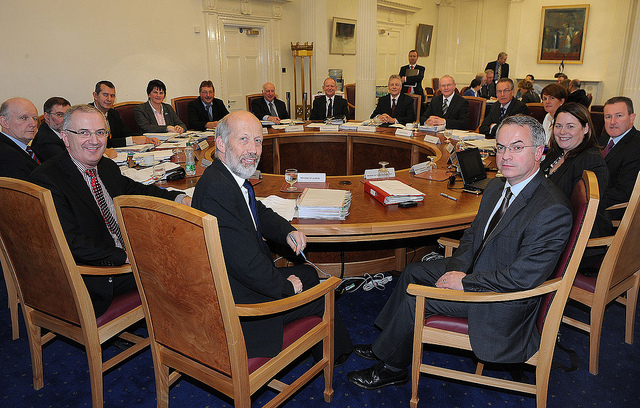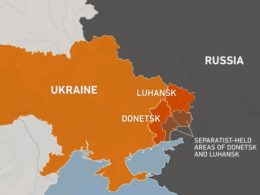By Michael Cleary
On December 23rd the five Executive parties and the British and Irish governments signed off on the “Stormont House Agreement”. The Agreement came at the end of eleven weeks of intense negotiations which concluded with 30 hours of continuous talks. First Minister Peter Robinson has stated that the agreement is “a monumental step forward”. Deputy First Minister Martin McGuinness has described the resulting document as “astounding”. Former Haas talks co-chair Megan O’Sullivan has welcomed “a new era” for Northern Ireland politics.
This overblown rhetoric is, as ever, entirely misleading. Despite over 100 hours of talks there were no deals on the contentious issues around parades and flags. Instead one or more commissions to examine areas such as “identity” and “culture” will be established. These commissions will conveniently report after the next Assembly elections are out of the way in May 2016.
Consensus on Cuts
There was consensus around the talks table of course, but this was on the implementation of austerity. In recent months very sharp cuts have been announced across health, education and other areas. The Agreement makes it quite clear that Executive imposed austerity is not going away. And the recent statement from Ed Balls that he will stick to the Tory-LibDem Coalition plans for “deficit reduction” makes it absolutely clear that whoever wins the next general election austerity will continue.
So-called welfare reform has been in the aspect of the cuts which has been most prominent in the headlines over recent months. The Agreement will probably result in an arrangement which softens some of the worst aspects of welfare reform. Some measures, such as the bedroom tax, may simply not apply to Northern Ireland. There is clear disagreement between the Executive parties as to what extent protection will now be provided to those on benefits. Sinn Fein are suggesting that no-one will be worse off when welfare reform is voted through but other parties have rubbished this claim. It should also be remembered that while Sinn Fein have shouted from the roof tops that it is opposed to welfare reform in reality it agreed to the implementation of the main cuts to benefits many months ago, alongside the other Executive parties.
The main plank of the agreement is a massive programme of job cuts across the public sector. Twenty thousand jobs will go. All five parties are not just in favour of the cutting of thousands of jobs but actually boast of their ambition to “re-balance the economy” away from public sector and towards the private sector. This represents a total adoption of the neo-liberal argument that an over-large public sector holds back the development of the private sector. The logic of this argument is that the private sector is more dynamic and wealth-producing and that the public sector is slothful and wasteful.
The actual results of the shrinking of the public sector are apparent all over Europe. A tilt towards the private sector will mean increased casualisation of the workforce, with lower wages, reduced pensions, increased job insecurity, and a greater proportion of part-time and temporary jobs in the workforce. The private sector is superior to the public sector only in the sense that it is more efficient engine of exploitation.
No political party which proposes the cutting of 20,000 jobs in the public sector and the promotion of the private sector with all that this entails can legitimately claim to be on the left. Some parties, and some individual politicians, adopt left bluster but this is essentially meaningless. Proposals to make adjustments to a programme of austerity does not amount to opposition to the cuts. The Executive parties all accept the economic status quo. This leads directly to acceptance of a vicious austerity programme, supposedly the only way out of the crisis of the system.
The plan to cut the size of the public sector is linked both ideologically and practically to proposals to reduce corporation tax. If corporation tax is cut there will be a reduced tax take and the subvention from Westminster will be cut by the same amount. The Executive is proposing to make up the difference through saving on the public sector wages bill. This will be achieved both by mass redundancies and on-going “wage restraint”.
Again the Executive parties are not just in favour of reducing corporation tax but boast of their intentions to do so. It is claimed that a lower rate of corporation tax will result in up to 50,000 new jobs over the coming years but the evidence for such a claim is very dubious to say the least.
Essentially the proposal to lower tax on business is based on the “theory” that the rich need incentives to invest. The poor on the other hand require the whip of poverty to get them up and get working. The actual reality is that wealth is created by the working class through their labour but despite this the working class are the victims of the crisis.
Divided on “The Past”
Much of the Agreement focused on the needs of the victims and survivors of the violence of the last decades. Agreement in this area is limited, not least because the Executive parties cannot agree on the definition of a victim. New support will be provided for the health needs of the victims and survivors. This will fall short of what is required but will be welcomed by many. In every other way victims will be short-changed by the Agreement.
Victims and survivors, and all of those who lived through the violence, deserve not just improved health care but also a truthful accounting with the past. The proposals to examine the past included in the Agreement will not deliver the truth. The reality is that the sectarian parties seek to examine the past through the prism of today, seeking to confirm their analysis and reinforce their positions. They have no interest in exposing their own records to scrutiny.
A genuine examination of the past would expose the role played by sectarian parties, paramilitary groups and individuals. It would also expose the role of the state, which employed vicious repressive methods for decades. It is important to set out the record of all the contending forces. Shining the clear light of day on the past is essential in order to prevent the same forces dragging us back to conflict in the future. Only the workers movement, with a genuine record of trying to hold working class communities together during the worst of the violence, is in a position to deliver a credible account of the past.
What Will Happen Next?
The five Executive parties are indicating that they will sign it off the new agreement but as ever there is a risk of a short term upset. Already the abolition of the “panel” which was to examine a way out of the impasse at Twadell Avenue in North Belfast has been attacked by a number of loyalists, including prominent members of the PUP, and even by unionist politicians who were in the talks, such as Tom Elliott of the UUP. It is thus possible that the DUP will make a lot of noise around the issue of parades in coming days, in order to cover their exposed flank. Despite this it is most likely that the new agreement will be accepted by the leaderships of the five Executive parties and will be implemented, in fits and starts, in the coming months. Already the Sinn Fein leadership have accepted the deal.
A motion on welfare reform will be put to the Assembly in January. A budget will be agreed in the next number of weeks-in time for the new budget year which commences in April. A bill will need to go before the Westminster parliament in order to devolve powers to vary corporation tax to Stormont. This may well be fast tracked but it will still be April 2017 at the earliest before the Executive is in a position to lower the tax.
Much of the promised two billion pounds of extra finance in the Agreement, which is mostly in the form of loans, will be spent on redundancy payments for public sector workers. Some new cash is available but it is mostly ring-fenced for specific projects or will be set aside to make up welfare reform shortfalls. It appears that there is little new finance available for day to day spending. The possibility of raising cash through the sale of public assets and the introduction of new charges is clearly stated in the agreement. The Belfast harbour estate will probably be sold off. The total privatisation of Northern Ireland Water and Translink has been raised. The mention of new charges raises the spectre of water charges, but it is unlikely that the Executive will move in this direction in the short term.
The Executive may find ways to postpone some of the already announced cuts and some of the high profile suggested cuts which grabbed recent headlines may now not happen. This may mean that things may seem to “improve” for a time but the wave of real and immediate cuts which has angered working people in recent months will almost certainly continue. Furthermore, the public sector job cuts will have a dramatic effect in the months ahead. It is simply not possible to cut jobs on the scale that is envisaged and not to savage service provision.
The Executive will be in even more difficulty if the British economy slows down or goes into reverse. It used to be said that when Britain “catches a cold” Northern Ireland gets “pneumonia”. This was the case despite the fact that over the last four decades the size of the public sector has acted as a partial buffer against the worst ravages of recessions and austerity programmes. In part this was a conscious strategy on the part of the British state, desperate to maintain a semblance of stability in the North. In the future the cushion will not be there to anything like the same extent-the public sector will be smaller and the Westminster will have less cash to provide in the block grant.
Will Real Agreement Ever Be Possible?
It would be a mistake to draw entirely negative conclusions from the failure of repeated “agreements” to deal with any of the fundamental problems we face. Agreements in Northern Ireland are in fact not agreements in any real sense of the word. The main parties in the talks are not capable of agreement on sectarian issues such as flags, parades and the past, precisely because the parties base themselves on sectarian division.
The Socialist Party believes that real and genuine agreement is possible-the agreement of working class people and working class communities to come together in solidarity and in the struggle for a socialist alternative to division and misery.
The majority of the new generation of young people born since the ceasefires of 1994 are opposed to the social backwardness imposed by Northern Ireland’s sectarian politicians. They are overwhelmingly in favour of a woman’s right to choose and of full and equal rights for LGBT people. They are impatient for a Northern Ireland where all have the right to live in peace, free from threat and intimidation. They are fed up with the lack of opportunity and the lack of hope that characterises the North. They want an education which doesn’t leave them with a lifetime of debt. They believe that everyone is entitled to a good job on a decent wage. They don’t want to live in a society which is seemingly forever imprisoned by the past.
One Day Public Sector Strike
And thousands of rank and file trade unionists are preparing to take strike action against the cuts. A one day strike, involving all public sector workers and a layer of private sector workers, is planned for March 13th. The unions will launch strike ballots later in January. If union members vote for action the strike will potentially be the greatest display of trade union power, of the power of Northern Ireland’s organised working class, since the one day strike against Thatcher which shut down Northern Ireland in April 1980. It will be a powerful and inspiring example of what can be achieved when the working class unites and makes a stand.
A solid strike on March 13th will put down a marker and will send a clear message to the Executive. It is vitally important that trade union activists build for successful strike ballots in the coming weeks. Some trade union leaders may seek to row back on the decision to organise a one day strike, arguing that the Executive parties have achieved as much as can be achieved through negotiation with Westminster. In addition, the proximity of the general election, now only four months away, may be raised to throw dust in the eyes of workers with entirely erroneous claims that a Labour government will make a real difference.
A layer of trade union members will have genuine doubts about what can be achieved through strike action. A clear lead from the activist layer in the unions will help to dispel these doubts. Many workers understand that a one day strike will not be enough to force the Executive to backtrack on the cuts and that further strike action will be required. They are wary of the possibility that the decision to organise a one day strike is a cynical attempt to let off steam on the part of some trade union leaders. It is thus essential that we build for March 13th as a key day in a programme of resolute action, including further strike action.
Strike action must be targeted against both Westminster and Stormont. Most workers understand this but the issues are posed differently by some union leaders. In fact it is clear that some trade union leaders are of the opinion that the Executive parties are doing their best in difficult circumstances and have “no choice” but to implement the cuts. These leaders see the strike as a way of supporting the Executive in its struggle to see off Westminster imposed cuts.
This approach is fundamentally mistaken but any suggestion that some of the Executive parties are “better” than others, is potentially disastrous. Some trade union leaders have this approach, in effect seeking ways of lending support to the “anti-austerity” parties in the Executive against the “pro-austerity” parties. There is no such division in the Executive. All of the Executive parties are pro-austerity.
This does not mean of course that Executive parties will not try to use cuts issues to divide working class people in the run up to the general election on May 7th. Sectarian parties will argue for a “fair” distribution of cuts, claiming that the community from which they derive their electoral base is losing out more than the “other” community. If the unions are seen to come down on one side or the other in the midst of this process there is a real danger of increased tension in the workplace, and even of the outline of potential splits in the trade union movement emerging. Nothing less than the unity of workers in the workplace, defended by activists over the past decades, sometimes at the cost of their lives, is at stake.
The unions must direct their fight against both Stormont and Westminster. It is necessary to reject the entire basis of the austerity project and to demand a no-cuts budget be set at Stormont. The politicians at Stormont will only go down this road in extremis-if they feel a fire from below. The setting of such a budget would inspire workers elsewhere. We must seek to immediately link up with workers in struggle, or moving in the direction of struggle, in England, Scotland and Wales. Our allies lie there amongst the organised working class. Recent events in Scotland, where the working class and young people voted for independence in large part as a vote against austerity and in favour of society taking a new left direction, illustrate the pent up anger which lies just beneath the surface. There would have been negative repercussions for Northern Ireland if Scotland had voted “yes” but the impact on the potential for class politics should not be ignored for this reason. The impact of the Scottish referendum is still being felt. A working class revolt against austerity across Northern Ireland, England, Scotland and Wales would shake the political firmament.
Trade union activists must remain vigilant on these key issues. Trade union leaders who were found wanting in the past have, in the main, not been replaced, and are not about to be transformed into their opposite. The drawn out process of renewing the activist ranks of the unions, and of replacing leaders who will not lead with those who will, becomes more urgent with the passage of time. In the coming period the process will accelerate through an increase in struggle, and the conscious intervention of left trade union activists, including through the building of broad left formations in all the unions.
A Political Voice for the Working Class
Industrial action alone is ultimately not going to change the fundamental direction of our society. To achieve this, the Catholic and Protestant working class needs to organise politically through a mass party which represents the independent interests of working people.
A new party will have to deal with all of the difficult issues from its inception. It is simply not possible to pretend that divisions around the national question do not exist. Nor should we seek to unite in the present around social and economic issues and put off discussing a way forward on the difficult issues until the future. This would be to repeat the mistakes of the 1960s when the labour and trade union leaders stood aside and allowed sectarian elements to seize the initiative. The result was the violence and mayhem of The Troubles.
The Socialist Party has proposed dialogue and compromise on issues around contentious parades over the last two decades. Our position was initially attacked and derided but over time has become widely accepted as the way forward. Our position on the national question as a whole is to take a similar approach. We recognise that each community has rights but so too does the working class as a whole-the right not be drawn into an outright conflict in which everyone would lose.
A new mass working class party must be firmly against the coercion of either community and in favour of compromise and genuine agreement. A new party must base itself on the inherent unity of the working class in the workplaces and in the unions and consciously promote solidarity in day to day struggle. A new party must strive to raise the sights of working class and young people, above the real problems of division today, and towards the possibilities inherent in the fight for a socialist future. Then what unites us will become more important that what divides us. A socialist Ireland, with full and equal rights for all communities, and a voluntary socialist federation of Ireland, Scotland, England and Wales, will allow for the national aspirations of all to be met, whilst developing the maximum unity of everyone in these islands.
Socialists draw hope both on the lessons of the past and on the living reality of working class struggle today for inspiration. The clear evidence that many young people are seeking an alternative has echoes of the period of the mid to late 1960’s. Then a generation of young people rejected both the Unionist Party and the Nationalist Party and turned to the left. Workers stood together in a wave of militant strikes, mostly unofficial action organised by militant shop stewards with little or no reference to the trade union bureaucracies. The civil rights movement drew support not just from young Catholics but layers of young Protestants who supported its aims.
A naïve approach will get us nowhere, however. In order to change today’s reality we must stare it cold in the face. Forty years of conflict and bitterness has left its mark. Division on the ground is real, in particular in the most deprived areas. A sharp upsurge in sectarian conflict is possible at any time. That this can occur on an unheralded issue and unfold in unexpected ways should now be clear to all after the experience of the flags protests which began two years ago. The fact that there have been 600 recorded sectarian “incidents” at the peace lines over the last year alone bears witness to the dangerous rocks ahead.
Whilst disdainful of the reactionary stance of the politicians on social issues young people can see no alternative, no credible way of replacing the Stormont politicians. In this context many of the best young people, those who are most turned off by the sectarian status quo, simply emigrate. And even some of those who today consider themselves neither Orange nor Green will fall into their own “camp” in times of increased conflict and violence. Without a credible mass alternative the general election on May 7th will be a sharply polarised sectarian headcount. In the run up to the election much debate will centre on attempts to agree “unity” candidates in order to maximise the number of Unionist and Nationalist candidates returned. Within each community the battle for supremacy between parties seeking to sell themselves as the best representative of their community will continue.
For now the echoes of the 1960’s are faint indeed, but they are there. Northern Ireland has been called “a place apart”, different and removed from the rest of Europe. There is some truth in this, but even in the worst of times in the 1970s international events had an impact here. In the 1960’s the civil rights movement drew inspiration from across the globe.
Great events elsewhere will cause waves which wash up even on our shores. Young people in particular are alert to movements of youth in other places. An increase in struggle across Europe is now evident. Workers in Belgium participated in a magnificent general strike on December 16th. The election of a Syriza government seems most likely in the Greek general election in January. Such a government would be seen as on the left and in opposition to the European governmental consensus in favour of austerity, whatever steps it takes when actually in power. The movement against the water charges in the South has already inspired many north of the border. The development of an industrial or anti-cuts movement in Britain, most likely to develop after the election, will undoubtedly impact here.
The opportunity for the ideas of socialism to reach wider and wider layers will come again, not in a dim and distant future, but through the struggles ahead. The Socialist Party is organising now in both Catholic and Protestant areas and is growing in size and influence. Join us in 2015, make a difference in today’s struggles and fight for a real alternative to the sterile politics of sectarianism.












